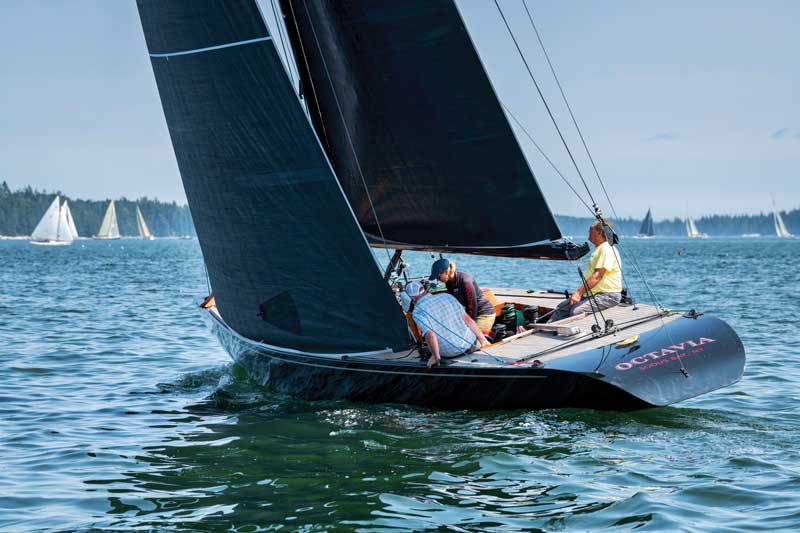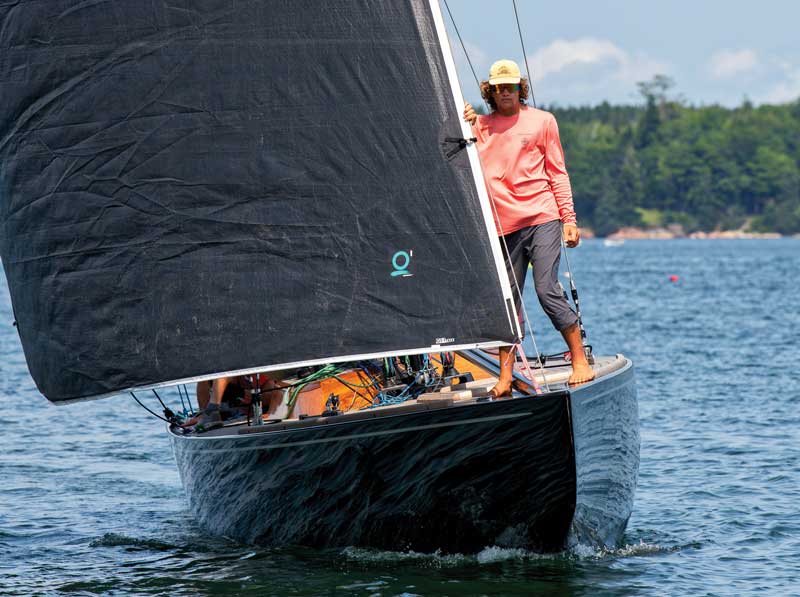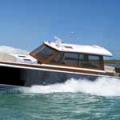Brion Rieff: 8-Meter Octavia
Brooklin Boatbuilder Launches a Bit of Yachting History
Photos by Tyler Fields
 Octavia ghosts along in light air at the 2023 Eggemoggin Reach Regatta, sailing in her first race after a six-year redesign and rebuilding program that returned her to the water nearly 40 years after she won the 8-Meter World Cup championship.
Octavia ghosts along in light air at the 2023 Eggemoggin Reach Regatta, sailing in her first race after a six-year redesign and rebuilding program that returned her to the water nearly 40 years after she won the 8-Meter World Cup championship.
After completing a six-year redesign and rebuilding process, boatbuilder Brion Rieff launched the 8-Meter yacht Octavia into the waters of Herrick Bay just in time for the one-time World Cup champion to sail in this past year’s Eggemoggin Reach Regatta.
The boat and the event are nearly the same age. The first ERR was held in 1985. Octavia, designed by Canadian naval architect Bruce Kirby and built by Bent Jespersen of Sidney, British Columbia, in 1983, won the 8-Meter yacht World Cup championship, which was sailed on Lake Ontario in 1984. She is generally credited with bringing the winged keel to the International 8-Meter class.
Rieff said he acquired Octavia via a trade and the yacht sat around his yard for several years before “a fellow I know that likes boats took a fancy to it,” and became interested in resurrecting the aging thoroughbred. That process involved replacing the original winged bulb keel and redesigning the hull so that it would be two feet wider at the transom than the original. Widening the boat involved splitting the hull down its centerline from about the keel location aft, installing new laminated ring frames, floors, and building a new, wider transom. The boat also got a newly designed cockpit and a new deckhouse incorporating the two bunks required by the 8-Meter class rules, and a new teak deck over new deck beams.
All the structural elements were laminated out of Douglas fir dressed with mahogany caps. The new hull sections comprised a cold-molded sandwich of several thin layers of mahogany between thicker inner and outer skins.
Adjustments to the rig included moving the mast 18 inches aft, back to its original location in the boat, and shortening the boom by 18 inches to account for the changed location. Mast and boom are aluminum (carbon spars are not allowed under the class rule) with stainless rod standing rigging. Winches, sail tracks, and miscellaneous deck hardware were supplied by Harken, but Octavia’s genoa and spinnaker sheet through-deck turning blocks were custom designed and built in the Brion Rieff Boat Builders shop in Brooklin.
For a motor, Rieff installed a Torqeedo 12 25-horsepower-equivalent pod drive with two 5,000-watt hour lithium-ion batteries and two 2,900-watt, 48-volt chargers for quick overnight charging.
 The bowman watches for traffic as Octavia heads for the starting line of the Eggemoggin Reach Regatta to race in the Modern Classic class.
The bowman watches for traffic as Octavia heads for the starting line of the Eggemoggin Reach Regatta to race in the Modern Classic class.
Octavia’s widened transom and new keel “made it a stiffer, better boat,” Rieff said, with “nicer sailing lines and a little bit more displacement back aft.” With its new 11,700-pound lead keel and an overall displacement of 17,700 pounds, the boat is quite stiff under sail, after an initial heel.
“They’re narrow,” explained Rieff, “so she gets sailing and heels almost to the deck. It doesn’t go anywhere after that. It just goes.” He estimated Octavia’s hull speed to be about eight knots.
Rieff’s collaborator on the Octavia project, Colorado-based Lightning sailor Jacob Vargish, refined the design for the new keel, which was a factor in the lengthy rebuilding process. Fabricated in Rieff’s shop, the keel is “definitely more radical” than the original. Some people have described it as “a Roman nose keel,” Rieff said. With a short chord length where it joins the hull, and a much longer chord at its lower tip—the chord length is the fore and aft measurement when viewed from the side—the keel didn’t require a bulb, though the design included an extremely tall trim tab and wings, all fabricated out of unidirectional glass fiber in Rieff’s shop.
The International 8-Meter class of racing yachts are not identical in the traditional one-design sense, rather they are designed to meet a specific measurement formula, the International Rule. The boats might vary in length—Octavia has an overall length of 44', an 8'8" beam and draws 6'5", while Pleone, a modern 8-Meter designed by Jim Taylor and a regular in classic yacht races along the Maine coast, has an overall length of just under 48 feet.
To qualify as an 8-Meter, a yacht must meet the formula “down to the millimeter,” Rieff said. He and Vargish worked with an official measurer throughout the design and construction process.
“At one point,” said Rieff, “we were rated over 8 meters.” As built, the boat measured at 8.17 under the formula and the measurer told the Rieff and Vargish that meant it was not an 8-Meter. The cure, Rieff said, was to shorten the foot of the mainsail by one inch.
All of the work on Octavia had a single purpose: to win 8-Meter class races on Lake Ontario where her owner sails, and where there is a small but competitive fleet of the classic boats.
“It’s like everybody wants to go fast,” said Rieff. “They’re a lot of fun. You never had so much fun and excitement doing six knots.”
✮
Stephen Rappaport is a writer and editor, has lived in Maine for more than 35 years, and is a lifelong sailor.
8-Meter OCTAVIA Specifications
LOA: 44'
LWL: 29'8"
Beam: 8'8"
Draft: 6'5"
Original Designer:
Bruce Kirby
Updated Design:
Jacob Vargish
Builder:
Bent Jespersen, Sidney BC
Rebuild:
Brion Rieff Boat Builders
76 Flye Point Road, Brooklin, ME
207-359-4455
www.rieffboats.com
Related Articles
Share this article:
2023 Maine Boat & Home Show

Join Us for the Maine Boat & Home Show!
Art, Artisans, Food, Fun & Boats, Boats, Boats
August 11 - 13, 2023 | On the waterfront, Rockland, Maine
Click here to pre-order your tickets.
Show is produced by Maine Boats, Homes & Harbors magazine.















